Overview: 8-String Basses
While Rickenbacker may be famous for making guitars with twice as many strings as one might expect, the same is not true of their basses. But they do exist! Rickenbacker played around with 8-string basses a couple times in the 60s and 70s before getting kinda serious in the 80s. Let’s run through them all, shall we?
The very first 8 string Rickenbacker basses used a pretty unlikely donor: the semi-hollow 4005. How the handful that were made and still exist have held up to all that string tension is a marvel! But they weren’t the first Rickenbacker basses to feature “extra” strings.

Appearing side by side with the “normal” 4-string 4005 at launch in 1965, the 4005/6 was tuned E to E like a guitar, and crowded 6 strings onto the same neck as the 4-string 4005. It did, however, get a honkin’ big headstock to hold the extra two standard bass tuners.
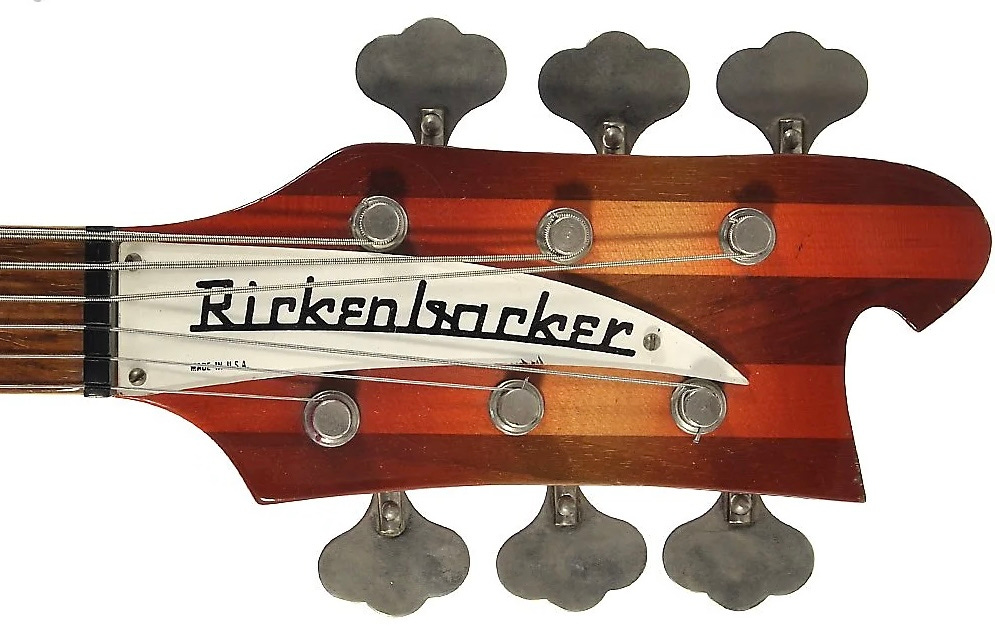
The 4005/6 remained in production through 1968, and on the price list until 1978. Not that many were made over that four year run—they are quite rare indeed!
Quick aside—people often wonder why so many Rickenbacker models remained on the price list for years after production ended. There are plenty of reasons that could be, but by far the most common one is that there was at least one of them sitting in the warehouse. And F.C. Hall’s theory was “you can’t sell it if people don’t know you have it!”
In 1967, though, somebody in sales went to the boffins in R&D and said “you know, we’re selling a whole lot of these here 12-string guitars. What about that, but bass?” Enter the 4005/8!

Strung “backwards” just like the guitars with the octave string second, the 4005/8 modified the the “R” tailpiece to accommodate the extra set of strings. How they handled the other end of the strings was…unique!
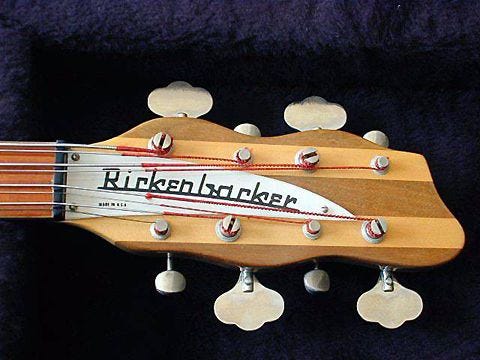
It’s actually a pretty clever design. Using guitar tuners for the octave strings helps keep the overall length reasonable, and the wavy sides allow the posts to line up while still providing easy access to the different sized tuning keys. It is a bit odd-looking though, and is commonly referred to today as the “potato head” headstock.

Were these guitars prototypes? Custom orders? We don’t know. Only a handful were made—probably less than five—and the model never made it onto the price list or into production.
But if examples of Rickenbacker’s first attempt at an 8-string bass are very rare, the next ones are even rarer still with only two ever produced—for two very special players.

Now the first thing I should point out is that there is some debate over the actual model designation of these guitars. Many people refer to them as 4008s because there would be an official (but quite different!) 4000-body 4008 later on. But given that there was a model 4001/8 added to the price list—but never produced—in 1975, I tend to believe it’s likely they were planning on turning this guitar into a production model but it just didn’t happen for whatever reason. Right or wrong, I’m calling these guitars 4001/8s.
If John Entwistle got the first one, who got the second one? Why, the owner of the arguably SECOND most famous Rickenbacker bass of course!
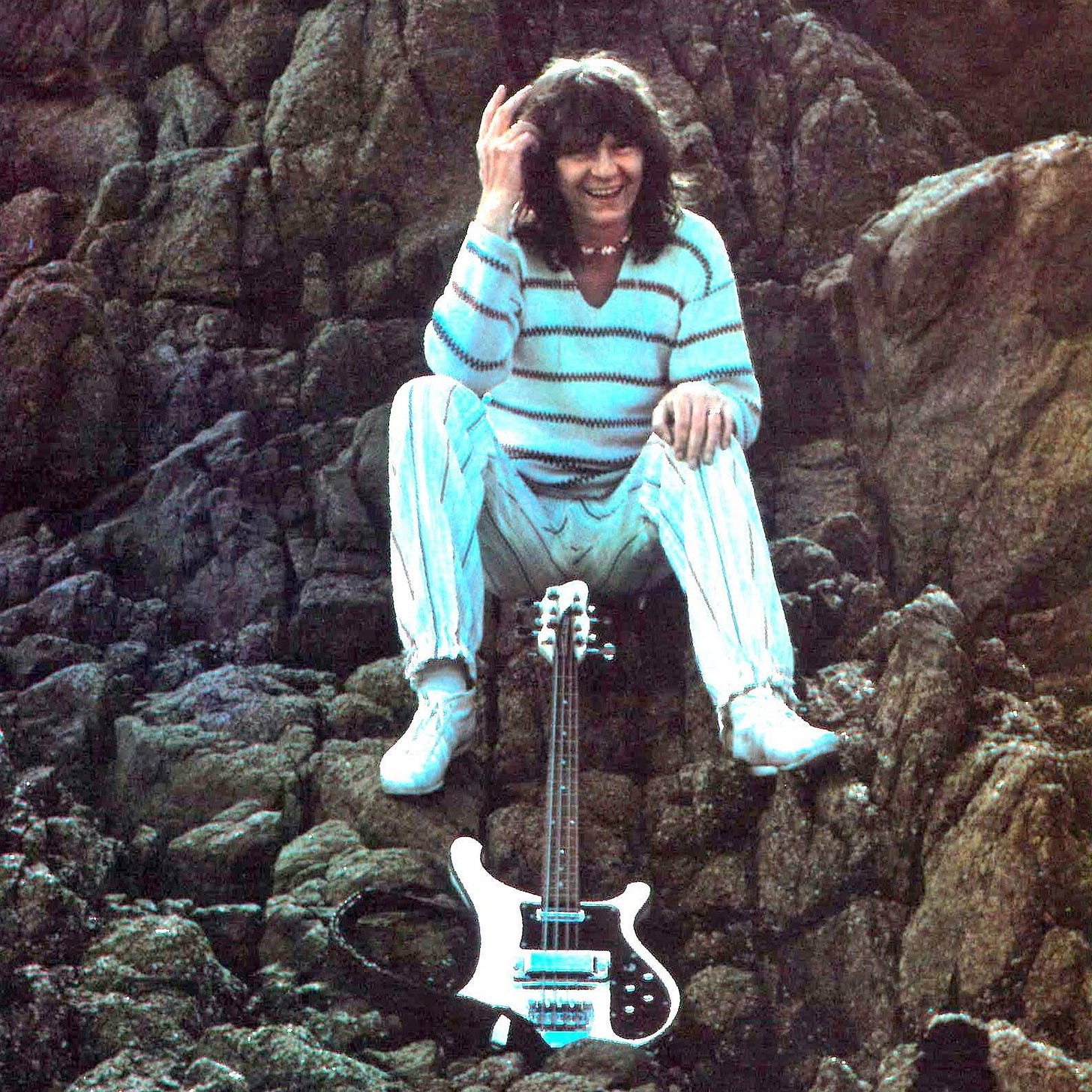
Now, good hi-res pictures of both guitars are hard to find, but here’s what we know they share in common—and where they differ. Built on the contemporary 4001 platform, the 4001/8 got the 4005/8’s potato-head headstock to handle the extra tuners. The neck featured an unbound 4001S fingerboard with dot markers. A stock 4001 bridge was modified to handle 8 strings by adding a second set of holes for the extra ball ends. Both guitars were finished in White with black trim—BEFORE the “Black Trim” era began in 1974—and may well be the first black trim Rickenbacker guitars.

The bridge pickup cover was removed at some point on Entwistle’s guitar and we therefore get a fuzzy peek at what APPEARS to be an 8 polepiece button top Higain. If that is so, it is likely—but not certain—that Squire’s was similarly equipped.
The bridge on Entwistle’s—but not Squire’s—was modified to remove the “teeth” between the strings over the mute. And oddly, Squire’s has the tuners reversed so that the octave strings come first like they would on a “normal”8-string, making the octave tuners difficult to access and the bass tuners protrude quite a bit thanks to the potato-head’s design for the opposite setup.

I have not been able to find enough good photos to say for certain if it came that way from the factory, but the photos I have seen seem to suggest it did—bass tuners (obviously) have much larger posts than guitar tuners, and the guitar tuners on Squire’s don’t APPEAR to have extra large bushings to “fill the gap” that would exist if the larger bass tuners had been removed.
Squire’s 4001/8 saw extensive stage use, but it does not appear that Entwistle’s ever saw a stage. It was used, however, on “Success Story” on 1975’s “The Who By Numbers”
While the 4005/8 and 4001/8 had been experiments or intellectual exercises, despite being Rickenbacker’s first “production” 8-string the 4008 was still very much a work in progress when it launched in 1982. But it represented a clear step towards its fully thought out 4003S/8 replacement.
Because so few 4008s were produced over the model’s four year lifespan and because it was immediately replaced with the evolutionary 4003S/8, the two guitars are often mistaken for each other. Luckily, the 4008 has three very obvious identifiers that distinguish it from the 4003S/8–which we’ll touch on in a moment!

The 4008 used the 4003S—with its stronger-than-the-4001 neck—as its foundation. The 4005/8 and 4001/8’s potato-head was with replaced with a more traditional—but long!—cresting wave headstock.

Unlike the potato-head 8-strings, the 4008 featured 8 bass tuners—Schaller M4s in this case to minimize their footprint. Imagine how long the headstock would have to be to hold Kluson-style tuners!
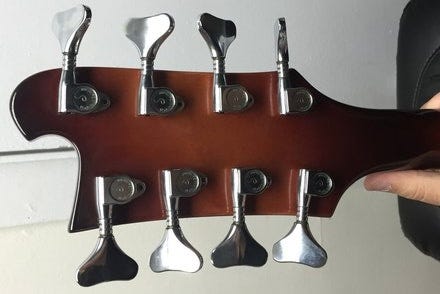
Fun fact: if I’m not mistaken the 4008 was only the second Rickenbacker to wear Schaller tuners—the first being the 4002. Rickenbacker would lean on Grover during the post Kluson closure 1982-1984 period before switching all tuners to Schaller-made units, making the 4008 a bit of an outlier for the period.
Unlike most of the 8-strings that had come before, the 4008 was strung “traditionally” with the octave strings first—although by using bass tuners for all strings, the nut could be replaced to allow stringing in “Rickenbacker reverse” style—a common occurrence.

The stock Rickenbacker bass bridge was modified even more than it had been on the 4001/8s. In addition to removing the “teeth” between the strings in the mute area as had been done on Entwistle’s guitar, the entire “back” of the bridgeplate was removed between the actual stock 4-saddle bridge and the ball end retention stop. The two extra mounting screws on the tail had been added to on the contemporary 4003 bridge to fight tail lift, and were especially necessary here!
Electronics were a toaster at the neck and a button top Higain at the bridge. That’s a bigger deal than your probably realize as the toaster was “brand new” for 1982 after having last been produced in 1974. This version, however, was the so-called “hot toaster” wound to about 12k ohms versus the original’s 7k-ish ohms. The 4008 (and 4003S/8) was, as far as I can tell, the only modern era non “reissue” guitar to feature a toaster pickup as standard until the 660/12TP in 1991.

Oddly for a guitar using the 4003S a a base, the 4008 featured stereo wiring instead of mono.

I said there’s three easily identifiable differences between the 4008 and 4003S/8. That’s one. The 4003S/8 came with mono wiring.
But it’s really more like three and a half. You’ll note the early 4003’s split pickguard on the the Fireglo 4008 above, but the red 1985 4008 doesn’t have one. So while not all 4008s have the split guard, no 4003S/8s do. So if you see a split guard, it’s a 4008. If it’s not split, it’s PROBABLY a 4003S/8, but not definitely. Clear?
The second clear differentiator is the fingerboard. The 4008’s was bound while the 4003S/8’s was not. The third…well, we’ll need to look at the 4003S/8 first before it will be clear.
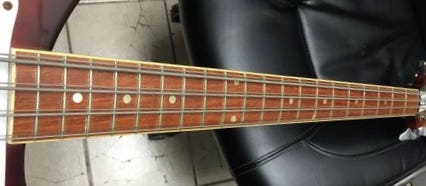
I want to very briefly mention some interesting things about the Red guitar above. 1985 was the beginning of the “Black Hardware/Black Trim” era, and this Red guitar was thusly equipped:
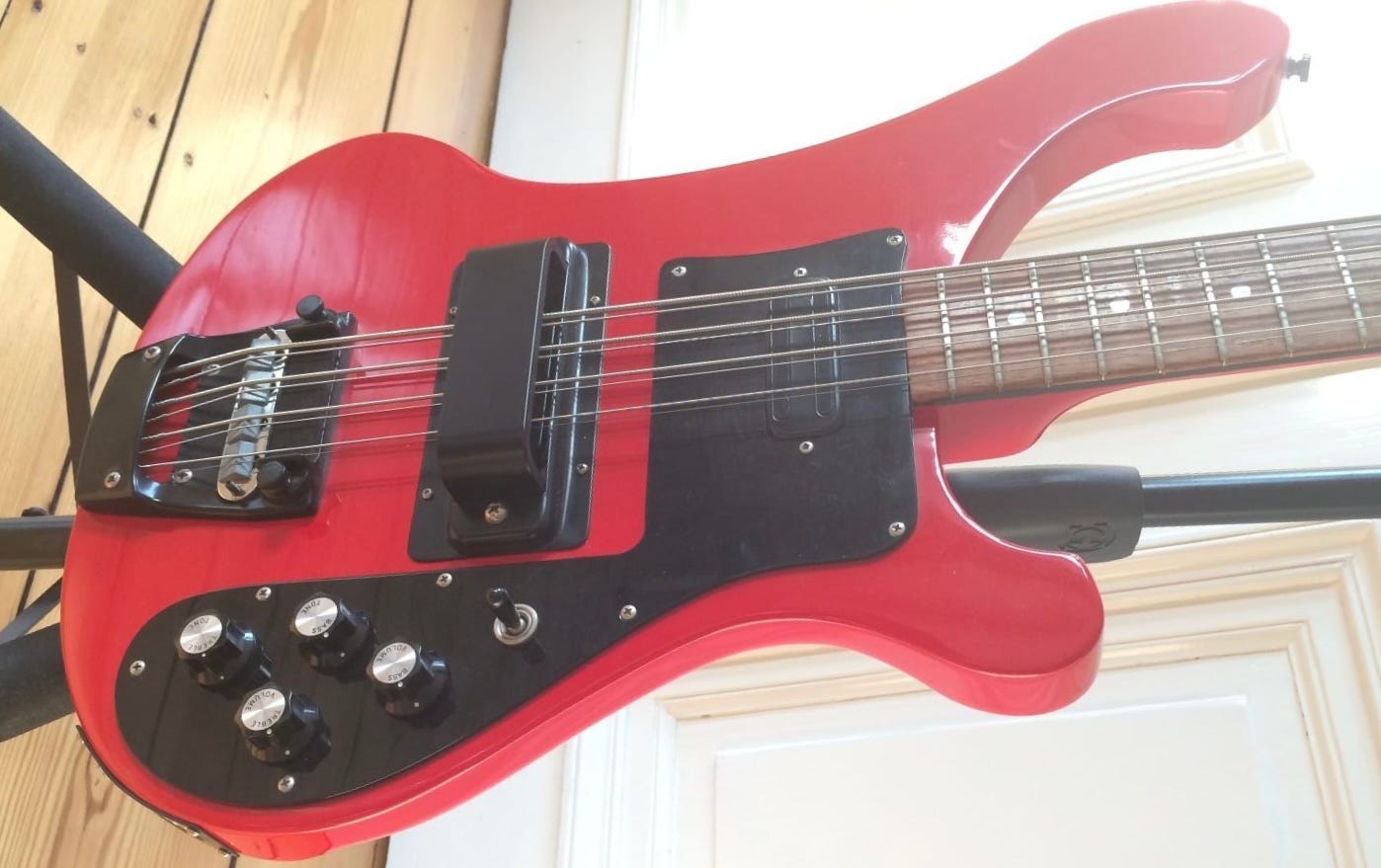
First notice that there is no neck binding on this guitar. BH/BT 4008s didn’t have it. But look closely at the neck toaster pickup. It’s blacked out like the rest of the chrome hardware. I did not believe that blacked out toaster covers existed in this period until I started looking at these guitars—no other guitars that came standard in BH/BT configuration featured toasters, and all BH/BT guitars I’ve ever seen with the vintage pickup/“VP” option box ticked have chrome toaster covers. I believe that the 4008 and 4003S/8 were the only Rickenbackers from the BH/BT era with this feature!
But before we move on to the 4003S/8, we need to talk about a mystery guitar. I have seen at least two of these, and I don’t quite know what to make of them.
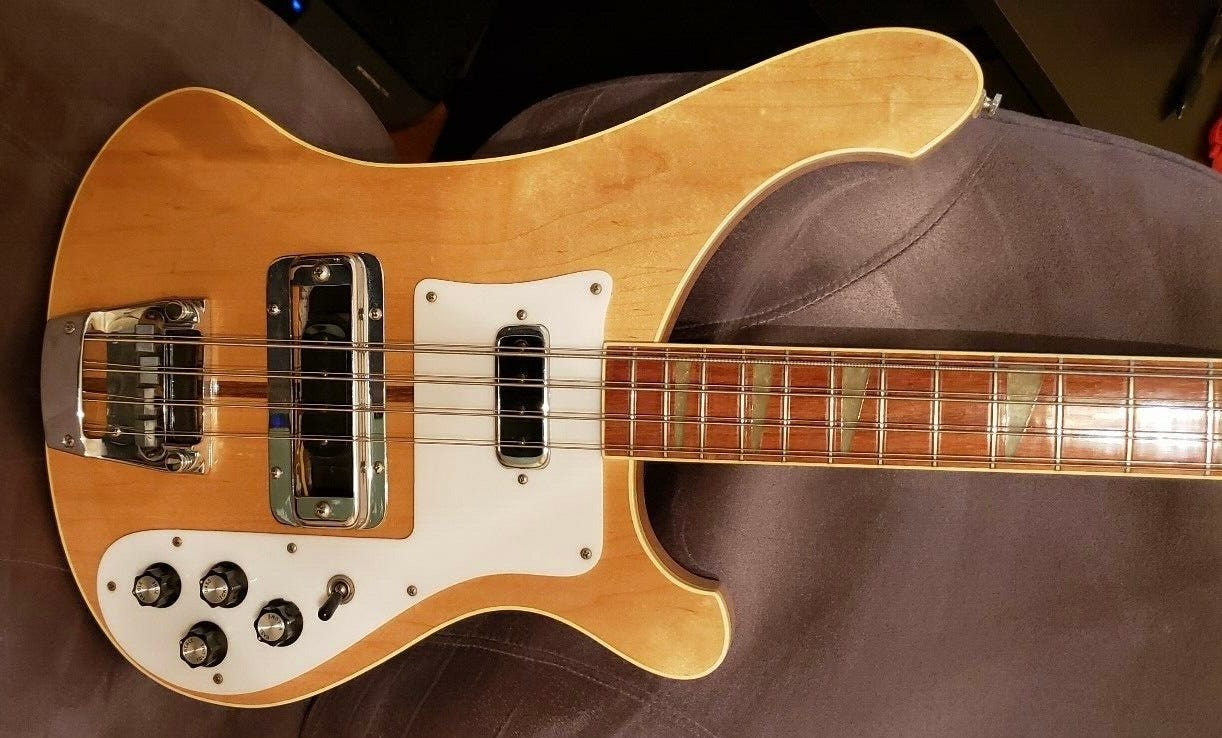
The headstock, tuners, and bridge on these guitars are identical to the 4008, but in all other aspects (skunk stripe neck, binding, triangle inlays, electronics, etc) it’s a 4001. Prototypes? Custom orders? I have no idea. I don’t even know what to call them—but they do exist.
The 4008 first appeared on the 1982 price list—and most of examples I’ve seen date to 1982 and 1983. It stayed on the price list but moved to the “custom order list” in 1984. When John Hall bought the company in 1984 he pretty ruthlessly trimmed the catalog down—and the fact that he retained the 4008 on the 1985 price list means that he planned on a future for an 8-string Rickenbacker. It just wouldn’t be the 4008.
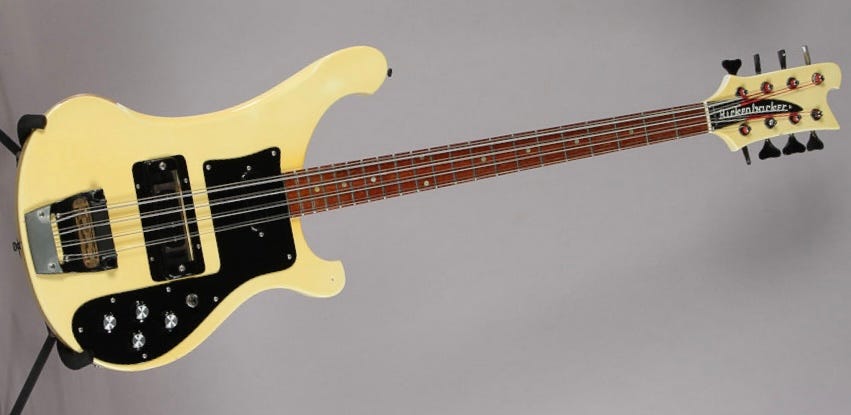
The 4003S/8 appeared on the price list and entered production 1986, and at first glance looks it more or less exactly like the 4008 it replaced. And for the most part it was. I mean, we’ve already discussed how it lost the fingerboard binding and the stereo wiring, but the other significant change was a little more subtle…until you see it. Then you can’t unsee it! Let’s put the 4008’s headstock back up here real quick:

Now let’s look at the 4003S/8’s:

The 4003S/8’s headstock is NOT actually any longer than the 4008’s. But it looks that way because of a little trick. Notice how the “points” on either side of the headstock below the bottom tuners are much more closely aligned on the 4003S/8 than on the 4008. The bass side’s point has slid down to come closer to the treble side’s, which is unchanged.
That gives room to move the bass side’s tuners down a bit, and the overall effect is to make the tuners look a lot less crowded on the headstock—notice how on the 4008 the upper bass side tuner is almost into the “hump” of the cresting wave. The revised headstock is just much less awkward.
So no neck binding, mono wiring, and a modified headstock. Apart from those changes…pretty much the same guitar. But they were actually serious about selling this one. I can’t confirm this for sure, but I’m pretty sure they made more 4003S/8s in 1986 than 4008s over its entire 1982-1985 run. While never a huge seller, it would become a consistent part of the line for over 15 years.
Now there were a couple minor changes/deviations from the standard 4003 timeline along the way. In late 1988/early 1989 the extra top two mounting screws were removed from the standard 4003 bridge’s tail. The 4003S/8 would (mostly!) keep the extra screws given the extra four strings. And then in 1991 they ran out of/stopped making more blacked out toaster pickup covers, so from that point on BH/BT guitars would get chrome toaster covers.

In 1992 the bridge would be modified—or perhaps “unmodified” is more appropriate. The “teeth” over the mute would return, and the “back” of the bridgeplate was no longer cut out. The only difference now between the 8-string and the stock 4-string bridge was the aforementioned extra two mounting screws on the tail and the extra 4 ball end holes in the end.

One quick note about the tail mounting screws seen in the picture above. It appears that when the bridge was modified in 1992 the screws were briefly omitted—but they were back in 1993 and would last until production ended in 2002.

Now I try to be as conclusive and factually correct as I can possibly be. But this one…I can’t be conclusive. I have opinions, but I’m not certain. I am certain that upon launch in 1986 the 4003S/8 left the factory strung in “normal, octave strings first” fashion—although plenty have since been changed to “Rickenbacker, octave strings last”. I BELIEVE that around mid 1993 that changed to a default setting of “Rickenbacker, octave strings last”. That’s certainly how promotional material showed it, and how most guitars appear today. But because so many of these guitars have had their string order changed over the years, I just can’t say for sure.
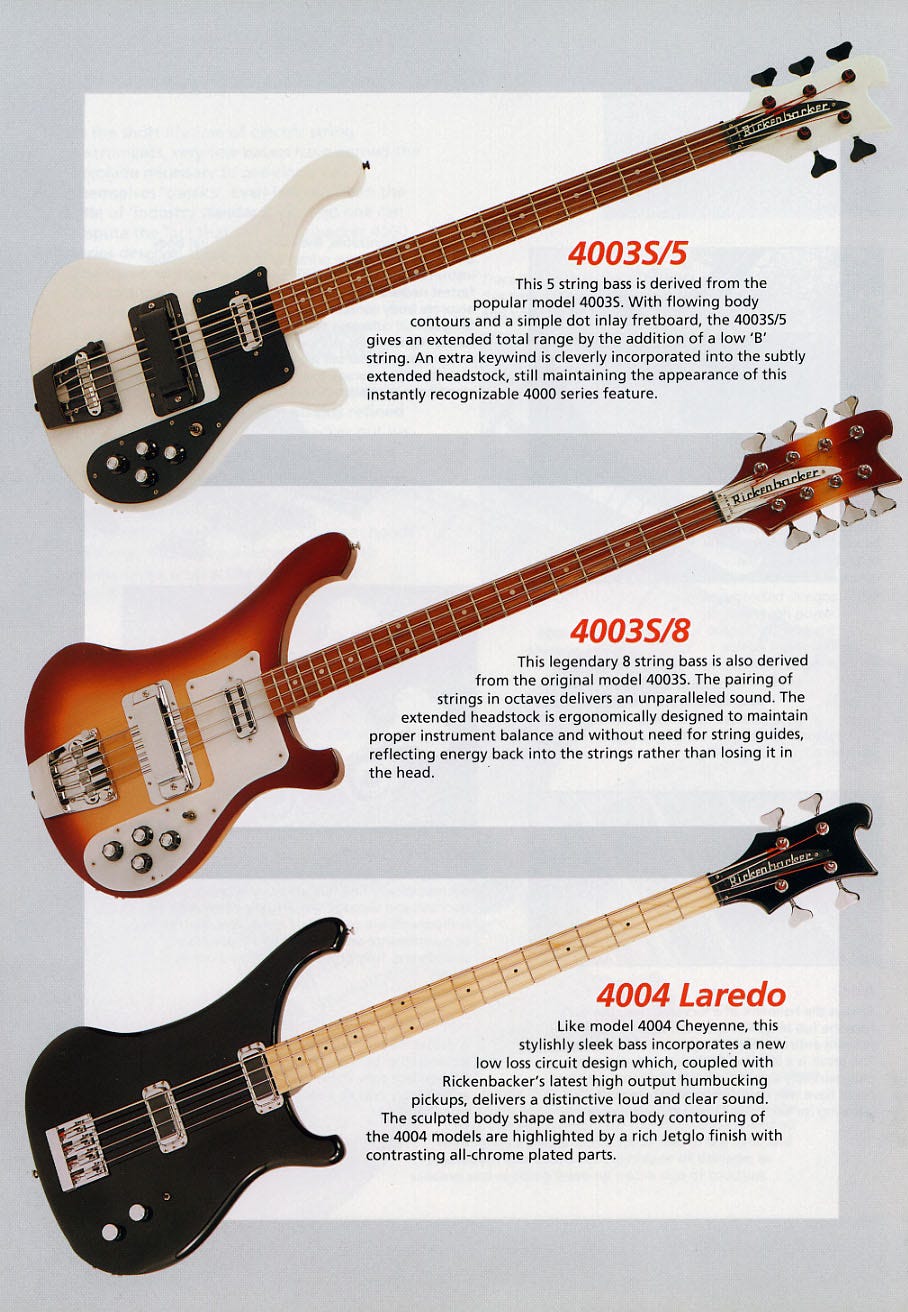
While there would be a few more minor changes to the 4003S/8 before it was discontinued in 2002, all of these changes were common to ALL 4003s—none were model specific. If you MUST know about them, you can read all about them here.
Before we wrap up our discussion of the 4003S/8, there’s one very special version we should mention. From 1987 to 1990 Rickenbacker produced very unique versions of the 4003S bass in the Tuxedo, Blackstar, and Redneck. All three of these models featured black hardware/black trim (with some strategic chrome on the Blackstar) and body colored painted fingerboards. Only a very small handful of the Redneck version were produced (38 is an often-cited number), and of those at least two were 8-string 4003S/8s.
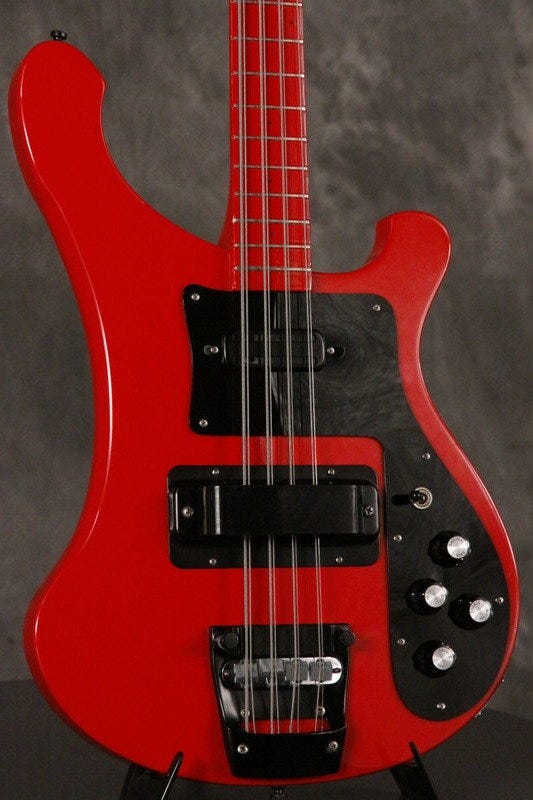
Compared to all other Rickenbacker 8-string basses, the 4003S/8 was a resounding success. Compared to the rest of the line—including the contemporary 4003S/5 5-string bass—less so. I have no many were made over its seventeen year run—somewhere around 200-300 wouldn’t surprise me. All other 8-string basses combined might add 50 to that…tops. Making Rickenbacker 8-string basses rare birds indeed. And now you know all there is to know about them!
Want to learn more about…everything else? Check out the rickenbacker101 site map and see what’s already been covered! Have a suggestion about what we should tackle next? Drop it in the comments and we’ll add it to the queue.

